Science Lesson: DNA Testing (Forensic Science and Cutting Edge Medicine)
Preface
DNA Testing is prominent topic discussed throughout the media and even permeates pop culture through the (many… god so many) Crime Scene Investigation (CSI) shows and the Maury Povich show’s never ending stream of paternity tests. We are all familiar with the increasing need for strong DNA evidence in criminal proceedings, and with doctors ordering genetic screens on cancer patients/survivors to check whether the patient/survivor is predisposed to a recurrence of the disease. What many of us may not be familiar with is how these tests work and what doctors and researchers, or prosecutors and defense lawyers are looking for. This post will seek to shed some light on these seemingly mysterious tests and break them down into a digestible format. So let us begin first with the method scientists use to amplify DNA in test tubes called the Polymerase Chain Reaction (PCR).

Source
What is PCR?
The Polymerase Chain Reaction is a multi-step amplification reaction that utilizes a few ingredients: A DNA polymerase Covered in Science Lesson: DNA Part 2, a double stranded DNA template, single stranded DNA primers and deoxyribonucleotide triphosphates (dNTPs , the building blocks of DNA aka A, T, C and G). The components of the PCR reaction are assembled together in a small plastic tube (plastic is essential as it can withstand the necessary heating and cooling steps that take place during the reaction). Initially the reaction is heated to a high temperature (94-98 °C) (Figure 1, 1: Denaturation). This step causes the double stranded DNA to “melt” splitting the strands in two. The reaction is then cooled to allow the DNA bases to re bond together. The single stranded primers included in a PCR reaction are complementary to two regions on either side of what you are interested in amplifying. The cooling step allows these primers to bind to the regions on the template they are complementary to (Figure 1, 2: Annealing). The next step is a heating step to the optimal temperature for a DNA polymerase to use the included dNTPs and extend the DNA primer along the length of the target (this is largely controlled both by the duration of time allowed at this optimal temperature and also the location of the two primers) (Figure 1, 3: Extension).
Figure 1: Polymerase Chain Reaction
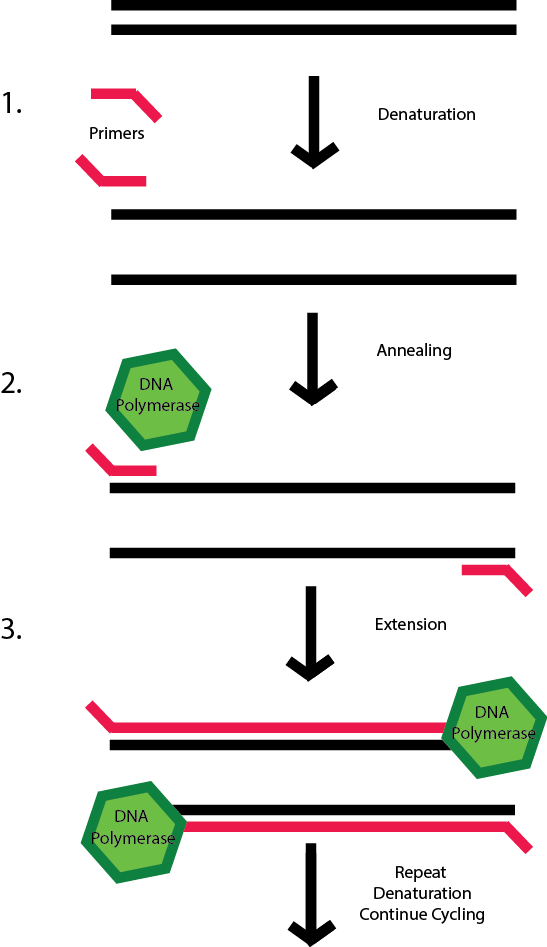
Source: Self
The DNA polymerases used in these reactions come from organisms which thrive at very high temperatures. One prominent PCR polymerase comes from the organism Thermus aquaticus “Taq” (Figure 2), a bacterium which grows optimally at 70 °C, in contrast the DNA polymerases in your body work best at 37 °C and will not function at elevated temperatures.
Figure 2: Thermus aquaticus
After the extension step the reaction is re-heated to the denaturation temperature to split the strands, and the process is repeated usually for 25-30 cycles (A cycle is each step in order: denaturation, annealing, extension). The cycling of the reaction causes an exponential amplification of the region of DNA you made primers to amplify, and using this we can generate large enough quantities for further analysis!
Restriction Enzyme Based DNA Footprinting
Another important tool that we need to understand is DNA footprinting. As you might now genetic material between humans is very similar, in fact it is 99.9% similar. However it is also very large, if you added up all the base pairs in the 23 human chromosomes, the total is a staggering 3 billion. Which means that the 0.1% difference across the human population means that there are over 3,000,000 variations in a single one of those base pairs. Each person has their own unique set of these variations, whether they have arisen from mutations during their lives, or were inherited from their parents.
There are specialized enzymes called restriction enzymes which will cut DNA into pieces. These enzymes are unique because rather than just cutting anywhere they want, they look for a specific sequence. One of the earliest discovered restriction enzymes came from our old friend E. coli and it is named E. coli restriction enzyme 1 (EcoRI). EcoRI cleaves DNA whenever it finds the sequence GAATTC, and this is how footprinting comes into play. We can cut up a person’s DNA with EcoRI (or a variety of other restriction enzymes with their own unique recognition sequences SalI: GACGTC, NdeI: CATATG) and look at the pattern of sizes that is generated. The patter from one person will be different from another person because of the unique set of variations in the sequences of their respective genomes. This creates a genetic “footprint” for each person.
Okay Great @justtryme90, Blah Blah DNA Blah, But How Does a Paternity Test Work?
A paternity test takes advantage of the aforementioned DNA footprinting. The Mother, Child and Father (in the case of Maury’s paternity tests potential Fathers) all have their DNA footprinted. This chopped up DNA is run through an agarose gel ( this is a material made out of the sugar agarose, which forms a mesh, DNA is pushed through the gel by an electric current, smaller DNA pieces migrate through the gel faster than larger ones) where the footprinting patterns can be observed (Figure 3).
Figure 3: A Maury Paternity Test Gel
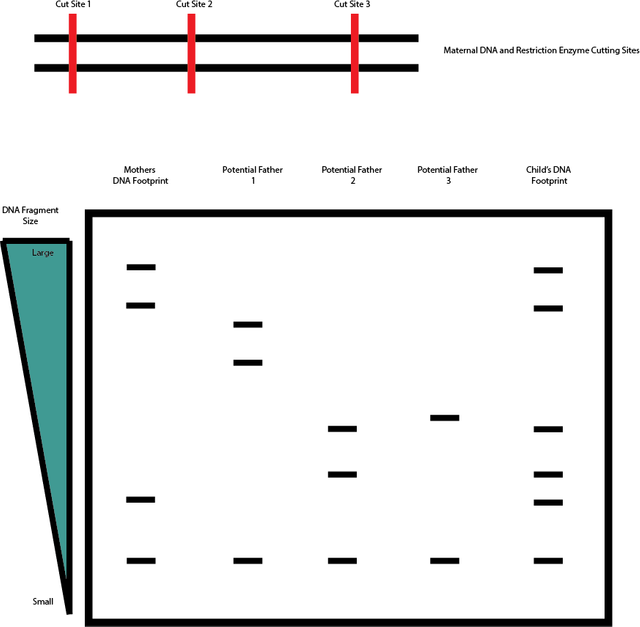
Source: Self
In the above example we have DNA footprinting results from a mother, her child, and three potential fathers. DNA is obtained from all of the people (usually through a cheek swab) and the DNA is cut by a restriction enzyme as I described earlier. The child is the genetic combination of its parents, thus the sum of the footprint of both of its parents (not exactly, but for this example lets simplify things a little). So we can see that the child’s footprinting pattern is the equivalent of the footprints from the mother and potential father #2. Congratulations potential fathers 1 and 3, you are NOT the father. Potential father #2 can now look forward to child support payments based on the results of our genetic test.
Crime Scenes and a More Complicated Footprinting
Another interesting use of footprinting is done by crime scene investigators, here unlike in paternity test cases, the amounts of available DNA are microscopic, sometimes only a single strand of hair or maybe some semen haphazardly sprayed about. In these cases restriction enzyme analysis is not possible, there isn’t enough DNA to visualize it on a gel. It is here that forensic scientists turn to the PCR method I mentioned above to amplify specific places in the genome. The areas that are chosen are called variable number tandem repeats, they are repeating sequences that occur over and over again for different numbers of repeating units in everyone. So you have a unique set of these repeats, and it can be used to identify whether DNA at a crime scene didn’t come from you (note I say didn’t, it’s easier to conclusively eliminate someone when they don’t match then it is to prove it is someone when there is a match). Researchers do a PCR reaction on some of these repeat sequences and run the DNA generated on a gel much like the one from Figure 3 above. If the sizes of the DNA generated from your repeat sequences, do not match that of the sizes from the DNA at the crime scene, then you have a very compelling case that it couldn’t have been you!
Wait… What About Genetic Tests for Cancer?
To understand this we must discuss DNA sequencing. For this I will discuss the oldest and easiest to understand method Sanger Sequencing. This is a PCR based technique where a gene is amplified, but in the reaction are include nucleotides that will terminate a growing chain. We set up 4 reactions, one with each nucleotide terminator ( a C terminator, a G terminator an A terminator and a T terminator ). Then the reactions are again run on a gel (Figure 4).
Figure 4: Sanger Sequencing
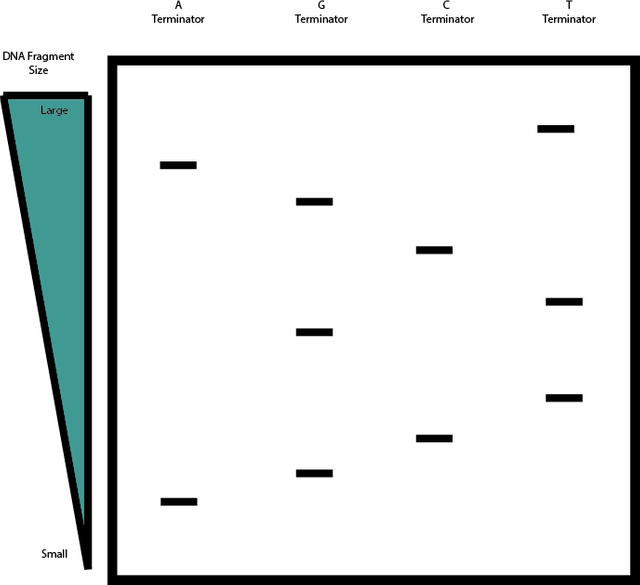
Source: Self
In this sort of experiment we just write down the sequence in the order of smallest to largest (we actually use computers to call the bands and determine the sequence). So were we to do this we know the sequence the PCR reaction generated was AGCTGTCGA, which means the sequence of the gene we were amplifying is the complement to that (remember A pairs with T and C pairs with G) so the sequence from the gene was TCGACAGCT as those are the bases that pair with the ones we obtained from sequencing. Sequencing is used to determine the sequence for genes that when mutations arise in them, lead to the development of cancer. One such set of genes is BRCA1 and BRCA2, doctors will have these genes sequenced in cancer patients and if they find mutations in either one or both, it is indicative that the patient would have a higher chance of developing cancer, or cancer returning if they are in remission. There are more powerful sequencing techniques available now then Sanger sequencing, but the principles in general remain the same.
Concluding Remarks
There are a variety of ways that DNA can be broken down and analyzed, and each of these methods is useful for telling you some information about the source or content of the DNA. Restriction enzyme analysis is inexpensive, but requires a lot of DNA. It’s great if you have a good source of it (like cheek swabs) and are only interested in making a comparison. Cost increases when you start including PCR into analysis as more enzymes are needed and these are expensive and/or time consuming to produce. Cost continues to rise when you need to do DNA sequencing, however modern advancements in technology are allowing this to be significantly less expensive than it once was. I hope you feel a bit more comfortable now with genetic tests, and what is going on under the hood of these sensitive, and powerful diagnostic uses of DNA technologies.
If you like my work, please consider giving me a follow:
I am a PhD holding biochemist with a love for science. My future science blog posts will cover a range of topics in the biology/chemistry fields.
If you would like to donate directly, please utilize the great new steempay service!

Thank you for your support of my work!
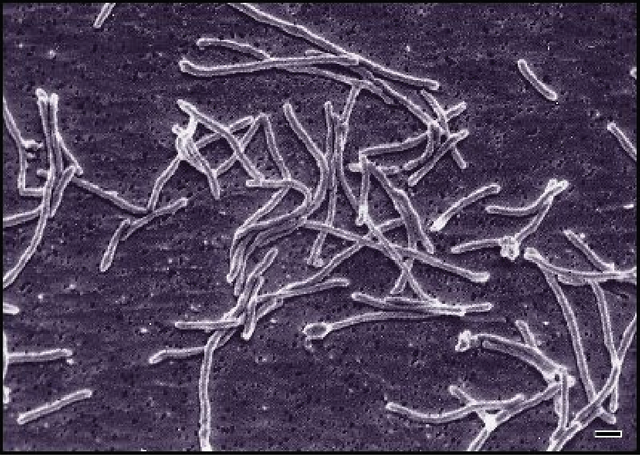
It's science!
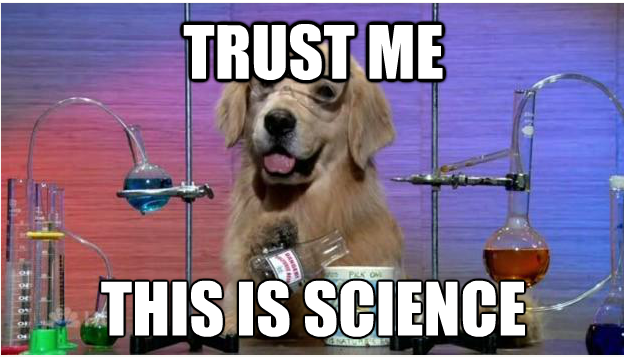
That golden knows two things, how to retrieve, and what science is.
YEP, OJ is still guilty!
The handling of DNA evidence is very important, I think we have learned a lot since the OJ Simpson trial. :)
It will be fascinating to see where advancements in DNA technology take us over the next few decades. It's truly an amazing time to be alive.
I really LOL at this one.....
Thanks, I know science can be really dry! I try to put at least a few entertaining bits inside :)
It is working! :-)
It's good to see a brief overview from a specialist, because when I looking at different companies offering dna testing (like "get to know your potential diseases, best diet or suitable sports"), there's mostly feedback from the bloggers who was tested for free, and the whole thing looks less scientific that it should be. (I know it's just a marketing, but still)
Have you pass any dna testing yourself?
I haven't had any done on me outside of things I have done to my self. So no, but I'm happy that so far my health has been good enough that I can avoid them.
Nice one :-)
Thank you!
it's good to see a brief overview from a specialist, because when I looking at different companies offering dna testing
E P I C post. Science is amazing.
Thank you condra
CSI stuffs Love ❤️ It
UPVOTES for @justtryme90
Supported Sweet ❤️👍👍👍
Very nice. Look forward to more science topics.
I have a bunch more ideas, some of which will require a bunch of additional research on my part. However that is exciting to me because I get to learn more about topics I haven't forced my self to dive into deeply yet!
I'm going to do the same. I'm thinking about doing more neuroscience and psychology type stuff. The difficulty is making it readable and accessible. Reading and writing science/medical papers tends to make you think and speak in that same stilted and hard to comprehend manner. It is hard to distill these things down for lay readers. You don't want to make it like a sensationalised newspaper article but you also don't want to make it boring.
That's a concern that I have with my own posts. How can I hold the attention of the reader such that they leave having learned a bit, with out that seeming like a chore. I don't know if my posts are there just yet, however it's something I am thinking about and hope to further improve upon in future posts.
I love reading about neuroscience and psychology, so I look forward to your coming posts when you do find the time and energy to create them!
Authors get paid when people like you upvote their post.
If you enjoyed what you read here, earn $4 of Steem Power